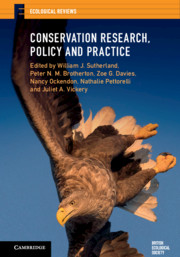Book contents
- Conservation Research, Policy and Practice
- Ecological Reviews
- Conservation Research, Policy and Practice
- Copyright page
- Contents
- Contributors
- Introduction and scene setting
- Part I Identifying priorities and collating the evidence
- Part II Influencing and making decisions
- Part III Communicating the message
- Conclusion
- Index
- Plate Section (PDF Only)
Index
Published online by Cambridge University Press: 18 April 2020
- Conservation Research, Policy and Practice
- Ecological Reviews
- Conservation Research, Policy and Practice
- Copyright page
- Contents
- Contributors
- Introduction and scene setting
- Part I Identifying priorities and collating the evidence
- Part II Influencing and making decisions
- Part III Communicating the message
- Conclusion
- Index
- Plate Section (PDF Only)
- Type
- Chapter
- Information
- Conservation Research, Policy and Practice , pp. 329 - 336Publisher: Cambridge University PressPrint publication year: 2020
- Creative Commons
- This content is Open Access and distributed under the terms of the Creative Commons Attribution licence CC-BY-NC-ND 4.0 https://creativecommons.org/cclicenses/

